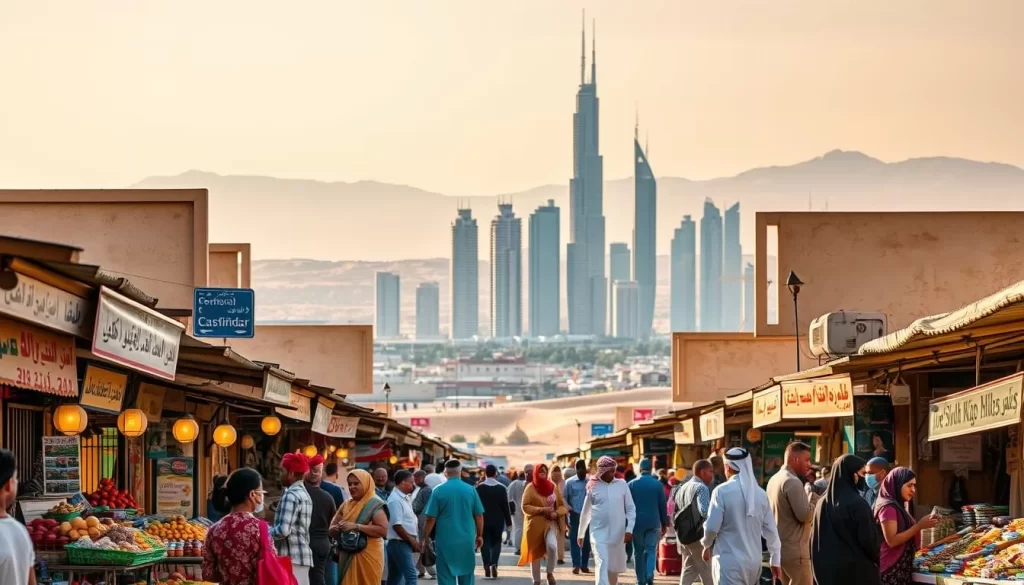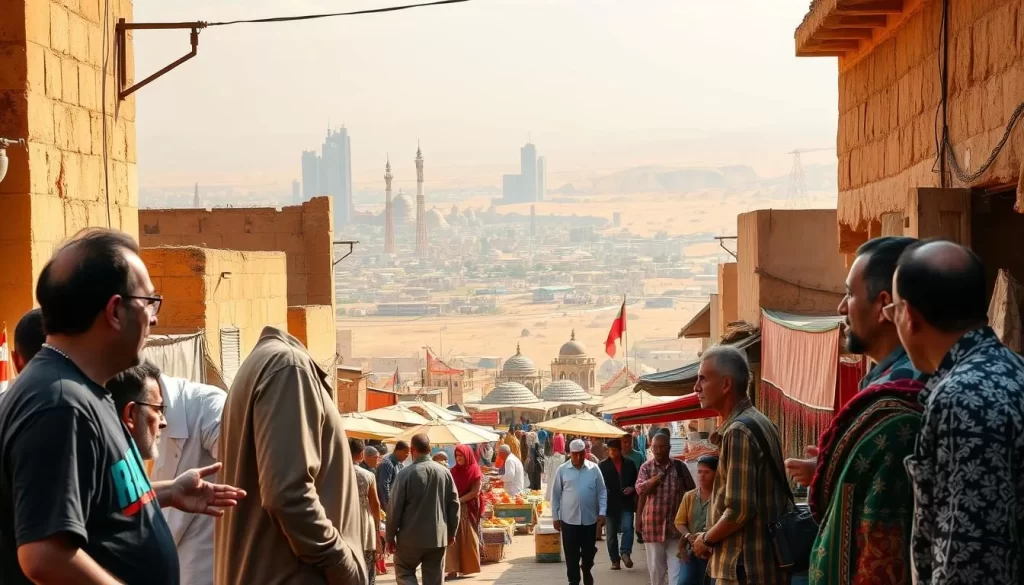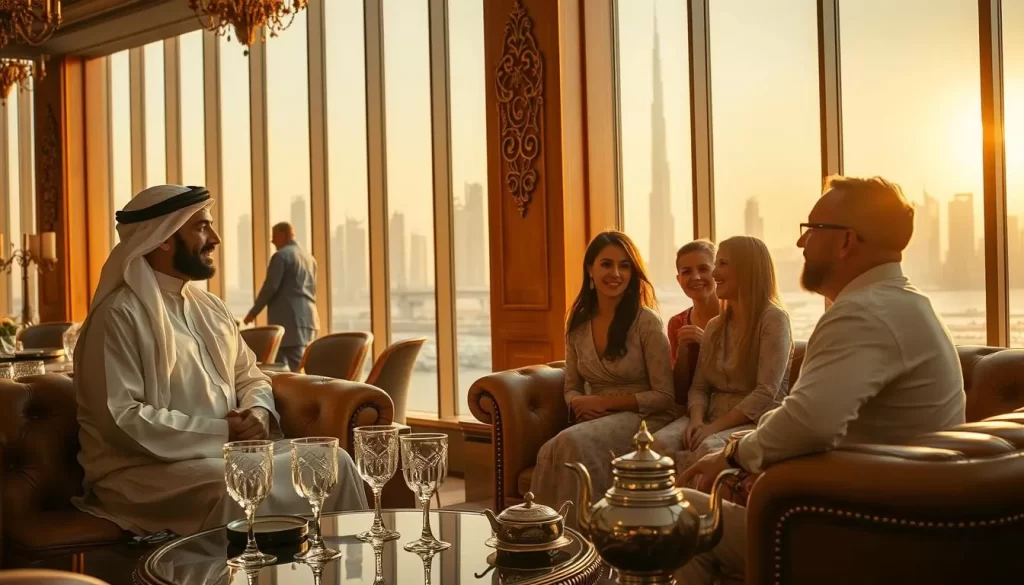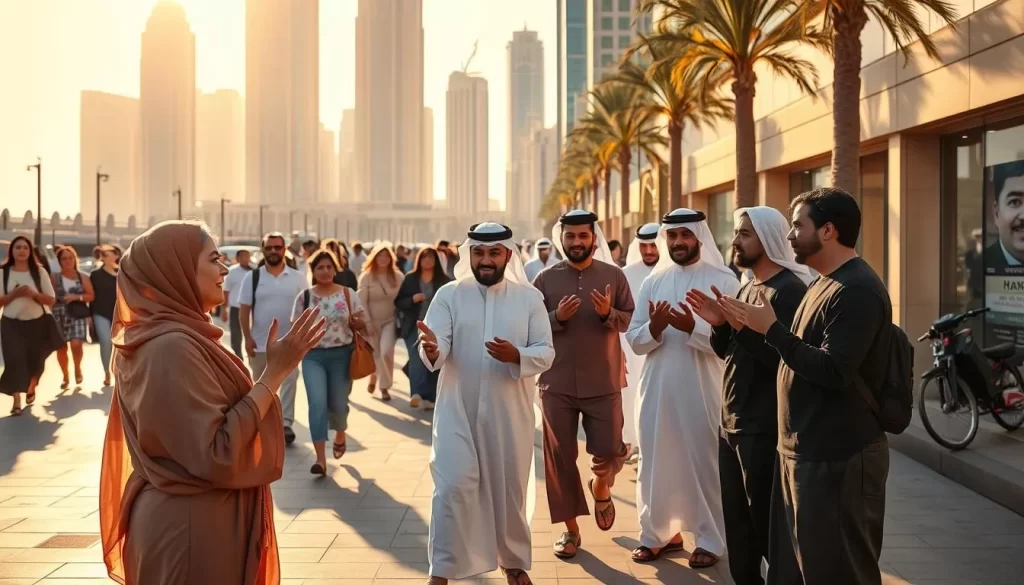✓ Accommodations ✓ Flights ✓ Rental Cars ✓ Tours & Activities
The United Arab Emirates is a vibrant country on the southeastern coast of the Arabian Peninsula. Known for its luxurious lifestyle and diverse cultural heritage, it’s a melting pot of traditions and languages. Arabic is the official language, shaping the nation’s identity and daily life.
English is also commonly spoken, reflecting the country’s global connections and expatriate communities. With a population of over 11 million, the UAE blends native Emiratis with a rich mix of ethnic groups. This diversity creates a unique linguistic landscape, influenced by centuries of history and modern globalization.
Understanding the role of language in the UAE offers insight into its cultural significance. It’s a place where tradition meets modernity, and communication bridges diverse communities. Explore how this dynamic shapes the country’s identity and global presence.
United Arab Emirates: Official and widely spoken languages
In the UAE, language plays a dual role in shaping daily life and global connections. Arabic, the official language, is deeply rooted in the country’s culture and identity. English, however, is equally prominent, especially in business and education.
The government actively supports the preservation of Arabic while promoting multilingualism. This approach ensures that traditional values coexist with modern globalization. For instance, road signs and official documents are often in both Arabic and English, making communication accessible to all.
In business settings, English is the preferred language for international transactions. Many companies require employees to be fluent in English to engage with global clients. This reflects the UAE’s position as a hub for trade and commerce.
The population of the UAE is a melting pot of cultures, with expatriates making up a significant portion. This diversity has led to the widespread use of languages like Hindi, Urdu, and Bengali. Such linguistic richness enhances the country’s social and economic fabric.
Understanding the role of language in the UAE offers insight into its cultural and institutional development. It’s a place where tradition meets modernity, and communication bridges diverse communities.
A Diverse Linguistic Heritage in the UAE
Languages from around the world converge in the UAE, creating a unique cultural tapestry. This diversity is a part of what makes the country a global crossroads. Arabic, the official language, blends seamlessly with languages brought by expatriate communities, enriching the nation’s identity.

In this vibrant region, you’ll hear Hindi, Urdu, Bengali, and many other languages daily. These languages are not just spoken; they are woven into the fabric of society. They influence everything from business to daily interactions, making the UAE a true melting pot.
The UAE’s linguistic diversity also reflects its global connections. English, for instance, is widely used in business and education. This multilingual environment fosters inclusivity and bridges cultural gaps.
Understanding this linguistic heritage offers insight into the UAE’s cultural richness. It’s a place where traditions meet modernity, and communication unites people from every corner of the world.
Arabic: The Official Language and Cultural Bedrock
Arabic serves as the cornerstone of cultural identity in the UAE. It’s not just a language; it’s a unifying thread that connects education, religion, and daily life. In Abu Dhabi, the preservation of Arabic is a top priority, ensuring it remains the heart of the community.
Role in Education and Religion
Arabic is the primary language in schools across the UAE. It’s used to teach subjects like history, literature, and Islamic studies. This ensures that students stay connected to their heritage. In religious contexts, Arabic is essential for reading the Quran and performing prayers.
Abu Dhabi’s educational institutions emphasize Arabic proficiency. Many schools offer bilingual programs, but Arabic remains the core language. This approach helps students appreciate their roots while preparing for a globalized world.
Preservation of Arab Heritage
Arabic plays a vital role in preserving the UAE’s rich cultural heritage. Traditional poetry, storytelling, and media are all rooted in the language. In Abu Dhabi, initiatives like the Abu Dhabi Cultural Foundation promote Arabic arts and literature.
Here’s how Arabic shapes the community:
| Aspect | Role of Arabic |
|---|---|
| Education | Core language in schools and universities |
| Religion | Essential for Quranic studies and prayers |
| Media | Primary language for news and entertainment |
“Arabic is the soul of our identity. It’s how we express our traditions and values.”
In Abu Dhabi, Arabic is also prominent in public spaces. From street signs to government documents, the language is everywhere. This ensures that it remains a part of daily life, even in a multicultural society.
Arabic’s role extends to the hotel industry, where staff often communicate with guests in both Arabic and English. This dual approach reflects the UAE’s commitment to preserving its heritage while embracing global connections.
By maintaining Arabic as the home language, the UAE ensures that its cultural identity thrives. It’s a testament to the country’s dedication to its roots, even as it evolves into a global hub.
Understanding Regional Arabic Dialects
Emirati Arabic stands out as a unique dialect shaped by centuries of trade and cultural exchange. This variety of Gulf Arabic reflects influences from historical interactions, migration, and local culture. Its distinct characteristics make it a fascinating subject for linguists and travelers alike.

Emirati Arabic Characteristics
Emirati Arabic is known for its rich vocabulary, blending traditional Arabic with loanwords from Persian and Hindi. These influences stem from the region’s historical role as a hub for trade and commerce. For example, words related to seafaring and pearl diving are deeply rooted in the dialect.
In daily life, you’ll notice unique phrases and expressions that set Emirati Arabic apart. These linguistic nuances reflect the region’s heritage and its connection to the Gulf. Schools in the UAE often emphasize teaching these dialects to preserve cultural identity.
Urban and Rural Variations
The way people speak Emirati Arabic can vary significantly between urban centers and rural areas. In cities like Dubai and Abu Dhabi, the dialect may incorporate more modern terms and international influences. In contrast, rural areas often retain traditional expressions and pronunciations.
Here’s a quick comparison of urban and rural linguistic traits:
- Urban: Modern vocabulary, influenced by global interactions.
- Rural: Traditional phrases, preserving historical roots.
These variations highlight the dynamic nature of Emirati Arabic. Schools and cultural institutions play a vital role in documenting and teaching these differences, ensuring they remain a part of the nation’s heritage.
“Language is the key to understanding a culture. Emirati Arabic is a living testament to our history and identity.”
By exploring these dialects, you gain deeper insight into the UAE’s rich linguistic landscape. It’s a journey through time, connecting the past with the present.
The Pervasive Role of English in the UAE
English has become a cornerstone of communication in the UAE, shaping its global identity. While Arabic remains the official language, English is widely spoken and essential for business, tourism, and international interactions. This mirrors trends seen in neighboring Saudi Arabia, where English is also highly valued.
In the UAE, English serves as the lingua franca for commerce and tourism. It’s common to hear it in hotels, schools, and corporate settings. This integration of English alongside Gulf Arabic and Standard Arabic ensures smooth communication in a multicultural society.
Language of Business and Tourism
English dominates the business world in the UAE. Many companies require employees to be fluent in English to engage with international clients. This reflects the country’s position as a global trade hub. Similarly, in tourism, English is the primary language for welcoming visitors and providing services.
Schools and universities also emphasize English proficiency. Over 80% of courses in sciences and economics are delivered in English, preparing students for global opportunities. This approach aligns with the UAE’s vision to balance traditional heritage with modern demands.
“English is not just a language; it’s a bridge that connects cultures and drives progress.”
For expatriates and international businesses, the widespread use of English offers significant advantages. It fosters inclusivity and ensures seamless integration into the UAE’s vibrant society. By embracing English, the UAE continues to thrive as a global crossroads.
South Asian Languages and Their Influence
South Asian languages like Hindi, Urdu, and Bengali are deeply woven into the fabric of the UAE’s expatriate communities. These languages are not just tools for communication; they are vital threads that connect people, cultures, and businesses across the emirate.
Expatriate Communication and Culture
In the UAE, South Asian languages play a key role in daily interactions. From bustling markets to schools, you’ll hear Hindi, Urdu, and Bengali spoken widely. These languages help expatriates maintain their cultural identity while fostering a sense of community.
For instance, in Dubai, Hindi is prevalent in retail and customer service sectors. Urdu is widely used in healthcare and education, while Bengali connects workers in construction and hospitality. This linguistic diversity adds energy to the social fabric, making the UAE a vibrant melting pot.
Economic Impact on Daily Life
South Asian languages also drive economic activity in the UAE. Businesses often rely on multilingual staff to cater to diverse customers. In the area of trade and commerce, proficiency in Hindi or Urdu can enhance customer relations and boost sales.
Here’s how these languages influence various sectors:
| Sector | Language Impact |
|---|---|
| Retail | Hindi and Urdu improve customer service and sales. |
| Healthcare | Urdu ensures clear communication with patients. |
| Construction | Bengali connects workers and supervisors effectively. |
“Language is the bridge that connects cultures and drives economic growth.”
By embracing South Asian languages, the UAE ensures inclusivity and strengthens its position as a global hub. Whether in schools, workplaces, or markets, these languages are a testament to the country’s cultural richness.
Neighboring Influences: Farsi and Persian Connections
Farsi’s influence in the UAE is a testament to centuries of shared history and trade. The northern emirates, in particular, showcase a unique blend of Arabic and Persian linguistic traditions. This connection has shaped the region’s dialect and cultural practices, leaving a lasting mark on its identity.
Historical and Trade Relations
The relationship between the UAE and Iran dates back thousands of years. Historical trade routes facilitated the exchange of goods, ideas, and languages. Farsi, with its rich literary heritage, became a bridge between the two regions.
Over the years, this exchange has influenced local dialects. Words and phrases from Farsi have seamlessly integrated into everyday speech, especially in the northern emirates. This linguistic adaptation reflects the deep cultural ties between the two nations.
Trade has also played a pivotal role in shaping the economy. The UAE’s strategic location made it a hub for commerce, attracting merchants from Iran. This economic interaction further solidified the linguistic and cultural connections.
Bilingual Communities and Economic Impact
Bilingual communities in the UAE benefit from these historical ties. Many residents are fluent in both Arabic and Farsi, enhancing communication in sectors like trade and service. This linguistic proficiency fosters stronger business relationships and cultural understanding.
Here’s how Farsi influences various sectors:
| Sector | Impact of Farsi |
|---|---|
| Trade | Facilitates smoother negotiations and partnerships. |
| Service | Enhances customer interactions in hospitality and retail. |
| Culture | Preserves shared traditions through language and art. |
“Language is the thread that weaves cultures together, creating a tapestry of shared history and mutual respect.”
The service industry, in particular, reflects these neighboring influences. From hotels to restaurants, Farsi is often used to cater to Iranian visitors. This approach not only boosts the economy but also strengthens cultural bonds.
To learn more about the evolution of the Persian language, visit this detailed resource. By understanding these connections, you gain deeper insight into the UAE’s rich linguistic and cultural heritage.
The Language of Luxury: French and Russian in the UAE
In Dubai’s high-end world, French and Russian are more than languages—they’re tools of exclusivity. These languages are integral to the UAE’s luxury market, enhancing the guest experience in prestigious hotels and tourist destinations.

French, often associated with elegance, is widely used in upscale venues. From fine dining to boutique shopping, it creates a sense of sophistication. Russian, on the other hand, caters to a growing number of affluent visitors from Eastern Europe.
Catering to International Visitors
Dubai’s luxury businesses strategically use French and Russian to connect with their clientele. High-end hotels often employ multilingual staff to ensure seamless communication. This approach reflects the UAE’s commitment to delivering premium services.
For example, in iconic hotels like the Burj Al Arab, you’ll find menus and concierge services available in both languages. This attention to detail enhances the guest experience and reinforces the UAE’s status as a global luxury hub.
Here’s how these languages impact the luxury sector:
| Language | Role in Luxury Sector |
|---|---|
| French | Enhances elegance in fine dining and fashion. |
| Russian | Caters to affluent visitors from Eastern Europe. |
“Language is the key to unlocking a world of luxury. In the UAE, French and Russian are more than words—they’re experiences.”
The investment in multilingual services has paid off over time. It ensures that every guest feels valued and understood. This approach not only boosts the economy but also sets a high standard for the hospitality industry.
By embracing these languages, the UAE continues to attract high-end visitors and maintain its reputation as a global luxury destination. To learn more about the linguistic diversity in Dubai, visit this detailed resource.
Embracing Global Languages in a Multicultural Society
With a rich tapestry of cultures, the UAE has become a hub for global languages, reflecting its diverse population. Over 200 nationalities call this nation home, creating a vibrant linguistic landscape. Beyond Arabic official and English, languages like Hindi, Urdu, and Bengali are seamlessly integrated into daily life, enriching the social fabric.
The uae government plays a pivotal role in fostering this diversity. Initiatives like the Ministry of Tolerance and the “Year of Tolerance” promote values of acceptance and respect for cultural differences. These efforts ensure that every language is celebrated, contributing to the nation’s evolving identity.
Expatriate Linguistic Diversity
Expatriates make up a significant portion of the uae population, bringing their languages and traditions. This diversity is evident in schools, workplaces, and community events. For instance, multicultural programs like the Emirati-Korean Cultural Exchange Program highlight the UAE’s commitment to inclusivity.
In education, bilingual programs and language classes cater to diverse communities. Media outlets also broadcast in multiple languages, ensuring everyone feels represented. This approach not only strengthens social bonds but also enhances the nation’s global appeal.
“Language is the bridge that connects cultures, fostering understanding and unity in a multicultural society.”
Organizations like Emirates Airlines exemplify this commitment by offering services in over 70 languages. Such initiatives underscore the benefits of a multilingual society, where communication bridges cultural gaps and drives progress.
By embracing global languages, the UAE continues to thrive as a modern, inclusive nation. Its dynamic linguistic landscape is a testament to the power of diversity in shaping a brighter future.
Sign Language: Fostering Inclusivity in the UAE
Sign language is transforming lives in the UAE, creating a more inclusive society for everyone. Emirati Sign Language (ESL) is gaining recognition and support, enabling better communication in education, media, and public services for the deaf community. This initiative ensures that every person feels valued and included, regardless of their hearing ability.

In major cities like Dubai and Abu Dhabi, ESL is being integrated into public spaces and services. From airports to hospitals, sign language interpreters are becoming more common, ensuring accessibility for all. This effort not only improves the quality of life for the deaf community but also enhances the experience for tourists visiting the UAE.
Empowering the Deaf Community
Education is a key area where ESL is making a difference. Schools are adopting bilingual programs that include sign language, ensuring deaf students receive the same opportunities as their peers. This approach fosters inclusivity from a young age, empowering students to thrive academically and socially.
The media is also playing a crucial role in promoting ESL. Television programs and online platforms are incorporating sign language, making information accessible to a wider audience. This shift not only raises awareness but also celebrates the linguistic diversity of the UAE.
“Inclusivity is not just a goal; it’s a way of life. By embracing sign language, the UAE is setting a global standard for accessibility.”
Public services are another area where ESL is being embraced. Government offices and community centers are training staff in sign language, ensuring that every person can access essential services. This commitment to inclusivity reflects the UAE’s dedication to creating a society where everyone feels welcome.
For more insights on how the UAE is addressing communication barriers, explore this detailed study. By fostering inclusivity, the UAE is not only improving the lives of its residents but also setting an example for the world.
Government Policies and Initiatives for Language Preservation
Preserving linguistic heritage is a top priority for the UAE government, ensuring Arabic remains a cornerstone of national identity. From the bustling airport hubs to the remote desert regions, comprehensive policies are in place to promote and protect the Arabic language.
These initiatives are designed to strengthen the federation’s cultural roots while embracing modernity. By integrating Arabic into education, media, and digital platforms, the UAE ensures its linguistic heritage thrives across the nation.
Educational and Media Strategies
Educational reforms play a pivotal role in language preservation. Schools across the UAE emphasize Arabic proficiency, blending traditional teaching methods with modern technology. Programs like “Bil Arabi” and “My Language” encourage students to engage with Arabic in creative ways, fostering a deeper connection to their heritage.
Media campaigns also contribute significantly. The Ministry of Education organizes competitions in Arabic calligraphy, poetry, and reading, ensuring the language remains vibrant in public life. These efforts are complemented by bilingual signage in public spaces, including airports, making Arabic accessible to all.
Digital Language Promotion
In the digital age, the UAE has embraced technology to promote Arabic. Online platforms and digital archives preserve the language for future generations. Initiatives like the Charter of the Arabic Language, launched in 2012, highlight the federation’s commitment to linguistic preservation.
Zayed University’s collaboration with global institutions to teach Arabic to non-native speakers is another example of these efforts. By leveraging digital tools, the UAE ensures Arabic remains relevant in a rapidly evolving world.
“Language is the soul of a nation. By preserving Arabic, we safeguard our identity and heritage.”
These policies not only protect the language but also strengthen the nation’s unity. From the desert to the airport, every initiative reflects the UAE’s dedication to its cultural roots. To learn more about these efforts, explore this detailed resource.
Conclusion
The linguistic diversity of this vibrant nation reflects its rich cultural heritage and global connections. With Arabic as the official language and English widely used, the country bridges tradition and modernity seamlessly. This blend creates opportunity for growth, fostering intercultural dialogue and economic progress.
Language plays a vital role in connecting religion, culture, and daily life. From education to business, the coexistence of multiple languages ensures inclusivity and accessibility. This harmony strengthens the social fabric, making it a welcoming place for all residents.
By embracing this dynamic linguistic landscape, you can appreciate how it shapes a forward-thinking society. It’s a testament to the power of diversity in building a brighter future. Explore more about this fascinating cultural blend here.
The above is subject to change.
Check back often to TRAVEL.COM for the latest travel tips and deals.
Here are some Tours & Sightseeing suggestions that might pique your interests!





